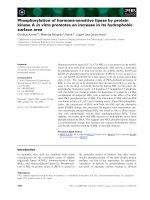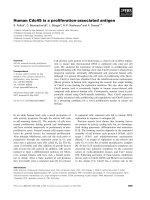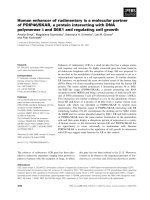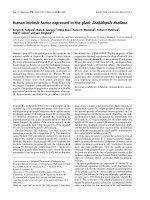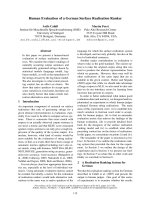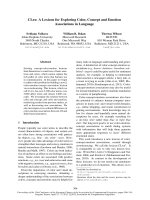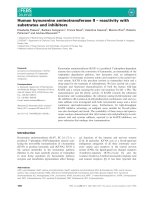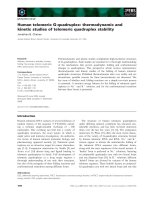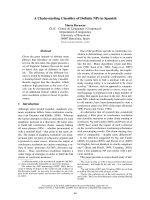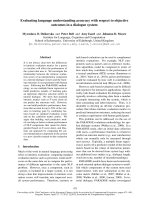Báo cáo khoa hoc:" Human spongiosa mesenchymal stem cells fail to generate cardiomyocytes in vitro" doc
Bạn đang xem bản rút gọn của tài liệu. Xem và tải ngay bản đầy đủ của tài liệu tại đây (2.15 MB, 14 trang )
BioMed Central
Page 1 of 14
(page number not for citation purposes)
Journal of Negative Results in
BioMedicine
Open Access
Research
Human spongiosa mesenchymal stem cells fail to generate
cardiomyocytes in vitro
Svetlana Mastitskaya and Bernd Denecke*
Address: Interdisciplinary Centre for Clinical Research (IZKF) "BIOMAT.", RWTH Aachen University, Aachen, Germany
Email: Svetlana Mastitskaya - ; Bernd Denecke* -
* Corresponding author
Abstract
Background: Human mesenchymal stem cells (hMSCs) are broadly discussed as a promising cell
population amongst others for regenerative therapy of ischemic heart disease and its
consequences. Although cardiac-specific differentiation of hMSCs was reported in several in vitro
studies, these results were sometimes controversial and not reproducible.
Results: In our study we have analyzed different published protocols of cardiac differentiation of
hMSCs and their modifications, including the use of differentiation cocktails, different biomaterial
scaffolds, co-culture techniques, and two- and three-dimensional cultures. We also studied
whether 5'-azacytidin and trichostatin A treatments in combination with the techniques mentioned
above can increase the cardiomyogenic potential of hMSCs. We found that hMSCs failed to
generate functionally active cardiomyocytes in vitro, although part of the cells demonstrated
increased levels of cardiac-specific gene expression when treated with differentiation factors,
chemical substances, or co-cultured with native cardiomyocytes.
Conclusion: The failure of hMSCs to form cardiomyocytes makes doubtful the possibility of their
use for mechanical reparation of the heart muscle.
Background
Human mesenchymal stem cells (hMSCs) are available
from bone marrow, umbilical cord blood and adipose tis-
sue. They are multipotent cells, which can differentiate
into specialized tissues, including bone, cartilage, fat, ten-
don, muscle, and stroma [1,2], and allow autologous
transplantation. Several studies have shown that hMSCs
are capable to differentiate into cardiomyocytes, smooth-
muscle cells, and even endothelial cells under certain con-
ditions [3-7]. MSCs transplantation obviates the need for
immunosuppression, even when allogenic stem cells are
used, since they do not express class II histocompatibility
complex and co-stimulatory molecules required for acti-
vation of T-cells [8,9].
Most studies on stem cell transplantation aimed at the
treatment of myocardial infarction in animal models and
human clinical trials have focused on the use of undiffer-
entiated stem cells, so that cardiomyogenic differentiation
would be expected to take place in vivo within a transplant
recipient. Nonetheless, since undifferentiated MSCs tend
to spontaneously differentiate into multiple lineages
when transplanted in vivo [5,10], it is likely that such
uncommitted stem cells may undergo unanticipated dif-
ferentiation within infarcted myocardium. This can in
turn reduce the clinical efficacy of the stem cell transplan-
tation therapy for myocardial infarction. Another major
consideration would be the safety of using uncommitted
cells for transplantation. Adult MSCs may differentiate
Published: 10 November 2009
Journal of Negative Results in BioMedicine 2009, 8:11 doi:10.1186/1477-5751-8-11
Received: 11 March 2009
Accepted: 10 November 2009
This article is available from: />© 2009 Mastitskaya and Denecke; licensee BioMed Central Ltd.
This is an Open Access article distributed under the terms of the Creative Commons Attribution License ( />),
which permits unrestricted use, distribution, and reproduction in any medium, provided the original work is properly cited.
Journal of Negative Results in BioMedicine 2009, 8:11 />Page 2 of 14
(page number not for citation purposes)
into fibroblasts rather then myocytes [10]. This may
enhance scar formation, further depressing myocardial
function and creating a substrate for life-threatening
arrhythmias. There also may be other life-threatening con-
sequences of undifferentiated MSCs transplantation. For
example, Forrester et al. [11] observed the sympathetic
nerve sprouting, resulting in myocardial sympathetic
hyperinnervation in swine that could cause ventricular
tachyarrhythmias [11,12]. Thus, it was postulated that a
certain cardiac differentiation of stem cells prior to trans-
plantation would result in higher engraftment efficacy, as
well as in enhanced myocardial regeneration and recovery
of heart function [3,6,7,13].
Since 1999, when Makino et al. first reported that bone
marrow mesenchymal stem cells treated with 5-azacytidin
are able to differentiate into cardiac cells that spontane-
ously beat in vitro [14], plenty of studies in the field of
directed cardiomyogenic differentiation of MSCs have
been done. Bone marrow-derived mesenchymal stem cells
have been reported to transdifferentiate into cardiomyo-
cytes following treatment with several growth factors
(TGFβ1, ILGF, PDGF, bFGF) and nonspecific differentiat-
ing inducers (5-azacytidine, dynorphin B, insulin, ascor-
bic and retinoic acids etc.) [13]. However, the types and
characteristics of these stem cells remain poorly defined,
and the efficiency of transdifferentiation greatly varies
between publications.
We report the results of our complex study on directed car-
diac differentiation of hMSCs in vitro, in which different
published protocols of cardiac-specific differentiation of
hMSCs and their modifications were examined to find the
most promising one, and to reveal the possible mecha-
nisms of hMSCs transdifferentiation. We attempted to
cover all principal trends discussed in literature, such as
use of growth factors, chemical inductors, biomaterial
scaffolds, and co-culture techniques.
Results
Untreated hMSCs
To demonstrate the multipotency of both types of isolated
hMSCs used in our experiments, spongiosa hMSCs and
aspirate hMSCs, differentiation into adipocytes and oste-
oblasts was carried out. Depending on the differentiation
protocol, induced hMSCs contained lipid vacuoles after
adipogenic stimulation, and produced calcium deposits
after osteogenic stimulation (Fig. 1A). Control cells (cul-
tured in stem cell medium without differentiation stim-
uli) retained their stem cell characteristics and did not
differentiate spontaneously (Fig. 1A). Untreated spongi-
osa and aspirate hMSCs from the same donor showed dif-
ferent morphology and cell growth kinetics. The
spongiosa hMSCs kept spindle shape over 7 passages and
high proliferation rate while aspirate hMSCs used to
become spread shape at early passages and demonstrated
a considerable slowing down of cells proliferation rate
after passages 3-4 already (data not shown). This tendency
remained also while using cardiomyogenic differentiation
protocols (for example, three-dimensional culture of aspi-
rate and spongiosa hMSCs in differentiation cocktail
(DC), Fig. 1B). Surprisingly, when examined untreated
cells for expression of cardiac markers, primary hMSCs
showed different repertoire of cardiac-specific genes
expressed depending on the source of the cells: 40 cycles
PCR revealed low levels of Nkx2.5, MEF2A, and MEF2D
gene expression in hMSCs isolated from bone marrow
aspirate, while primary hMSCs cells from spongiosa
expressed MEF2A and in a very low extent MYH7B (Fig.
1C). To our knowledge, it is the first time when the com-
parison of cardiac-specific gene expression by undifferen-
tiated hMSCs depending on the source of their obtaining
(spongiosa or aspirate) was done.
Aspirate hMSCs cultured in differentiation cocktail or in
IMDM, two- and three-dimensional culture
Aspirate hMSCs were used to test 8 different protocols for
cardiac differentiation of hMSCs in vitro (Fig. 2A). Immu-
nostaining with antibodies directed against cardiac tro-
ponin I, cardiac myosin heavy chain, myoglobin, and
smooth muscle actin did not reveal significantly increased
expression of cardiac-specific proteins in differentiated
cells from all passages, as compared to untreated cells
(data not shown).
Nonetheless, cells in three-dimensional culture in
medium containing insulin, dexamethasone and ascorbic
acid showed elevated levels of Nkx2.5 and cardiac myosin
heavy chain (MYH7B) gene expression (Fig. 2B and 2C).
The increase in Nkx2.5 expression was also observed in
cells pre-treated with 5-azacytidin (AZA) and trichostatin
A (TSA) in two-dimensional culture. However, the treat-
ment with AZA is not likely to be applicable "clinically"
due to its possible harmful effects. The expression of
MYH7B was revealed in all cultures. Nevertheless, the
detected negligible levels of Nkx2.5 expression in
untreated hMSCs, as well as MEF2A and MEF2D genes
(Fig. 1C), present evidence that these markers cannot be
considered as an obvious readout of hMCSs cardiac differ-
entiation. Among all examined methods of cardiomyo-
cyte-like cells generation from hMSCs in vitro, the three-
dimensional cultivation in presence of insulin, dexameth-
asone, and ascorbic acid (differentiation cocktail)
appeared to be the most promising. Probably, the intercel-
lular communication that plays significant role in proc-
esses of cell differentiation is much better in three-
dimensional culture. Therefore, this protocol was chosen
for further studies on spongiosa hMSCs cardiac differenti-
ation in vitro. Taking into account that untreated spongi-
osa hMSCs possess a higher proliferation rate and keep
Journal of Negative Results in BioMedicine 2009, 8:11 />Page 3 of 14
(page number not for citation purposes)
Spongiosa and aspirate hMSCs culturesFigure 1
Spongiosa and aspirate hMSCs cultures. (A) Spongiosa and aspirate hMSCs were cultured in stem cell medium alone
(undifferentiated) or in culture medium supplemented with stimuli inducing osteogenic differentiation (osteogenic) and adipo-
genic differentiation (adipogenic), respectively. In both, spongiosa hMSCs and aspirate hMSCs, mineralization nodules forma-
tion confirmed osteogenic differentiation and adipogenic differentiation was confirmed by lipid vacuols. (B) Figure shows the
photographs of the 3-D hMSCs cultures in differentiation cocktail on two different time points as well as 2-D cultures on start-
ing point of the experiment (day 0). Day 6: spongiosa and aspirate hMSCs cultured on nonadhesive Petri plastic dishes on the
day 6 by the method of hanging drops in differentiation cocktail. Day 18: the same cells transferred onto tissue culture plastic;
the spongiosa hMSCs culture almost reached 100% confluence while aspirate hMSCs still keep together in the form of bodies
and almost do not proliferate. (C) PCR from undifferentiated aspirate and spongiosa hMSCs and human adult heart tissue
demonstrating the expression of Nkx2.5, MEF2A, and MEF2D genes in undifferentiated aspirate hMSCs and MEF2A and
MYH7B in untreated spongiosa hMSCs. The expression of MEF2A and MEF2D genes wasn't revealed and ANP gene expression
was negligible in adult human heart tissue (the band marked with black star).
Journal of Negative Results in BioMedicine 2009, 8:11 />Page 4 of 14
(page number not for citation purposes)
Test of culture conditions for cardiac differentiation of hMSCsFigure 2
Test of culture conditions for cardiac differentiation of hMSCs. (A) Scheme of experiment on cardiac differentiation
of aspirate hMSCs in vitro. (B) PCR from human heart tissue and aspirate hMSCs used in 8 differentiation protocols (see A)
demonstrating the highest efficacy of two of them that led to the increase in expression of Nkx2.5 gene along with MYH7B
gene expression: 3D, DC and 2D, A/T+IMDM. (C) Clusterization of cell cultures based on the level of MYH7B, Nkx2.5,
MEF2A, and MEF2D gene expression. The cell cultures tested in this experiment formed two statistically different (P = 0.036,
ANOSIM) clusters at Euclidian distance of about 2.2. Note that the threedimensional cell culture in DC (3D DC) and the two-
dimensional culture in IMDM pretreated with 5-azacytidine and trichostatin A (2D A/T + IMDM) formed a separate cluster.
(2D - two-dimensional culture; 3D - three-dimensional culture; A/T - pretreatment with 5-azacytidin and trichostatin A; DC -
cells cultured in differentiation cocktail; NCM - normal culture medium; IMDM - NCM based on Iscove's Modified Dulbecco's
Medium; Differentiation cocktail - NCM based on DMEM-LG with components of differentiation cocktail).
Journal of Negative Results in BioMedicine 2009, 8:11 />Page 5 of 14
(page number not for citation purposes)
spindle shape in culture much longer then aspirate
hMSCs, the spongiosa cells were chosen for further exper-
iments.
Spongiosa hMSCs cultured in differentiation cocktail,
three-dimensional culture
The cardiac-specific gene expression by spongiosa hMSCs
cultured in the medium containing chemical inductors of
cardiac differentiation (differentiation cocktail, DC) was
studied during 3 passages as well as in long term culture
on RNA and protein level.
Flow cytometry revealed a slight increase in expression of
cardiac-specific markers (MYH7B, TnI, Nkx2.5) by spong-
iosa hMSCs cultured in DC at the late passages in compar-
ison to untreated cells (Fig. 3).
PCR analysis revealed increased levels of MYH7B and
Nkx2.5 gene expression in cells cultured 3-D by day 15 in
DC, followed by a decrease. MYH7B expression levelled
off by day 27 (passage 2), but then appeared again by day
40 (passage 3) (Fig. 4A and 4B). The same tendency was
clearly seen in long-term 3-D culture of hMSCs in DC
(passage 1, day 27 and 40). Currently, we can not explain
this observation. The highest level of MEF2D gene expres-
sion in 3-D culture was also observed by day 15. Since in
3-D culture untreated spongiosa hMSCs and cells in DC
after 5 days were negative for MEF2D, its appearance by
day 15 proves the efficacy of the cocktail. High levels of
MEF2A gene expression were present in cells throughout
all examined passages, as well as in the long-term culture.
As it was mentioned above, some cardiac specific genes
are already expressed in untreated cells, therefore, the suc-
cess of a given method can be judged according to the
level of their expression in differentiated cells. For
instance, the best result of MSCs treatment with DC in 3-
D cultures was observed by day 15, as it is seen from the
relatively increased levels of MYH7B, MEF2D and Nkx2.5
gene expression, along with unchanged expression of
MEF2A gene.
Spongiosa hMSCs cultured on biomaterials
The extra cellular matrix (ECM) provides a scaffold to
which cells can adhere and with which they can interact,
and that is required to cluster cells together. These interac-
tions affect a variety of different events, including gene
expression, cell proliferation, motility, and differentia-
tion. Different biomaterials could mimic different kinds
of ECM. The biomaterial used to cultivate stem cells can
potentially influence stem cell proliferation and differen-
tiation in both, positive or negative ways.
We have examined the influence of some biomaterials on
the efficacy of cardiac differentiation protocol based on
the use of differentiation cocktail (2-D culture). Five bio-
degradable matrices were selected on basis of their com-
patibility with hMSCs culture judged by cytotoxicity, cell
vitality, morphology, apoptosis, and proliferation studies
[15]: RG503, Collagen, PCL, Texin 950, PEA C. According
to the results of PCR, the most appropriate scaffolds for
cardiomyogenic differentiation of hMSCs could be
RG503 or Texin 950. Nkx2.5 and MEF2D genes were
expressed in cells cultured on all matrices as well as on tis-
sue culture plastic, but the highest levels of expression
were observed in cells cultured on RG503 and Texin 950
(Fig. 5A and 5B). The expression of MYH7B was not
detected in all cells with the exception of its negligible
level in cells cultured on RG503 (Fig. 5A). This phenome-
non could be explained by transient pattern of MYH7B
expression in spongiosa hMSCs cells cultured in differen-
tiation cocktail as it was previously discussed (Fig. 4A).
Co-culture of spongiosa hMSCs and Cor.AT cells
Most studies on cardiac transplantation of undifferenti-
ated MSCs relied on the hypothesis that stem cells acquire
cardiac phenotype under the influence of local microenvi-
ronment, which includes local production of cytokines
and growth factors, as well as direct cell-to-cell contact
and electrical coupling with native cardiomyocytes. In
view of this assumption, we have tried to define the cru-
cial mechanism of such impact. To determine whether
Expression of cardiac-specific markers by late passage (P3) spongiosa hMSCs cultured in 3-D culture with differentiation cocktailFigure 3
Expression of cardiac-specific markers by late pas-
sage (P3) spongiosa hMSCs cultured in 3-D culture
with differentiation cocktail. FACS analyses of differenti-
ated spongiosa hMSCs stained by antibodies against cardiac
myosin heavy chain (MYH7B), cardiac troponin I (TnI),
Nkx2.5 and smooth muscle actin (SMA). The slight expres-
sion of MYH7B, TnI and Nkx2.5 by all cells and SMA expres-
sion by some single cells was revealed.
Journal of Negative Results in BioMedicine 2009, 8:11 />Page 6 of 14
(page number not for citation purposes)
direct intercellular communication or molecular sub-
stances of cardiac milieu are required for efficient cardiac
transdifferentiation of hMSCs, we established direct and
indirect co-culture of spongiosa hMSCs and murine atrial-
like cardiomyocytes - Cor.AT
®
cells expressing GFP.
Immunohistochemical analysis did not reveal significant
increase in expression of cardiac-specific markers on days
14 and 25 of co-culturing (Fig. 6). For instance, in contrast
to the results of Xu et al. [16] who studied the co-culture
of murine bone marrow stem cells and rat neonatal cardi-
omyocytes, in our experiment hMSCs did not form gap
junctions with cardiomyocytes in direct co-culture on day
14 (Fig. 6A: 1b, 3b, 4b, 6b). However, the expression of
connexin-43 was detectable both in untreated hMSCs and
in hMSCs co-cultured with Co.AT cells on day 25 (Fig. 6B:
1, 3, 4, 6). Nevertheless, the expression of connexin-43 in
hMSCs does not prove heart differentiation of stem cells.
The detection of connexin-43 in undifferentiated spongi-
osa hMSCs could be explained by spontaneous upregula-
tion of a wide range of tissue-specific gene expression in
hMSCs. For example, mRNA coding for connexin-43 is
detectable in undifferentiated spongiosa hMSCs using
Chip Array Experiments ("GeneChip
®
Human Gene 1.0
ST", Affymetrix, data not shown). Apart from connexin-43
no differences in detection of analyzed cardiac-specific
markers were observed between day 14 and day 25.
The expression of transcription factor GATA4 was detected
in hMSCs and was clearly located in nuclei (Fig. 6A: 1a,
3a, 4a, 6a). The intensity of fluorescence signal given by
murine cardiomyocytes nuclei labelled for Nkx2.5 was
stronger then by hMSCs nuclei (Fig. 6A: 1c, 3c, 4c, 6c). The
expression of myocytes-specific marker myoglobin was
high in all hMSCs, but only in some hMSCs co-cultured
with Cor.AT cells in Cor.AT medium showed organized
structure (Fig. 6A: 4d and 6d; marked with a blue star).
Cardiac troponin I with clear structural organization pat-
tern was expressed only by cardiomyocytes and had dif-
fuse distribution in hMSCs (Fig. 6A: 1-6e). Human MSCs
are not likely to express the cardiac myosin heavy chain
(MYH7B) as the immunostaining analysis shows a dif-
fused pattern of the protein distribution, without any
organized structure. Murine cardiomyocytes were negative
for MYH7B, even though GFP of Cor.AT
®
cells are under
control of the cardiac myosin heavy chain promoter [17]
Cardiac-specific differentiation of spongiosa hMSC cultured 3-D in differentiation cocktail on different time points (passaged cells as well as longterm culture)Figure 4
Cardiac-specific differentiation of spongiosa hMSC cultured 3-D in differentiation cocktail on different time
points (passaged cells as well as longterm culture). (A) PCR from differentiated spongiosa hMSCs demonstrating the
temporary pattern of cardiac specific gene expression. The expression of MYH7B and Nkx2.5 was high by the day 15 and then
levelled off both in long-term culture and passaged cells. (B) Clusterization of cell cultures based on the level of MYH7B,
Nkx2.5, MEF2A, and MEF2D gene expression on different time points and passages. The cell cultures tested in this experiment
formed three statistically different (P = 0.01, ANOSIM) clusters at Euclidian distance of about 2.5. Note that one of the clusters
is formed by first passage MSCs cultured in differentiation cocktail for 15 days (P1, day 15).
Journal of Negative Results in BioMedicine 2009, 8:11 />Page 7 of 14
(page number not for citation purposes)
(Fig. 6A: 1-6f). It is likely to be explained by the lack of
cross-reactivity of the antibody used in our study against
murine MYH7B (mouse monoclonal antibody clone
2F4). All hMSCs kept high levels of lymphopoiesis differ-
entiation antigen CD44 expression while cardiomyocytes
were negative for CD44 (Fig. 6A: 1-6g). It is additional evi-
dence that hMSCs do not really differentiate into heart
cells, although the expression of some heart specific mark-
ers takes place.
Discussion
The main goal of the present study was to develop an opti-
mal protocol for directed cardiomyogenic differentiation
of human MSCs in vitro. The main findings of our work
are as follows: i) Three-dimensional culture in the pres-
ence of insulin, dexamethasone, and ascorbic acid
appeared to be the most promising method of cardiomy-
ocyte-like cells generation from hMSCs in vitro relied on
the use of simple chemical inducers of cardiac differentia-
tion pathways. ii) Pretreatment with 5-azacytidine and tri-
chostatin A does not lead to any significant increase of the
efficacy of differentiation protocols. iii) The biomaterials
Resomer
®
RG 503 and Texin
®
950 are promising for uses as
scaffolds in techniques of cardiac-like cells generation
from hMSCs in vitro. iv) Even untreated hMSCs demon-
strate some level of cardiac-specific gene expression, and
therefore, co-culturing of hMSCs with cardiomyocytes
does not result in a real transdifferentiation of hMSCs.
However, the expression of some heart specific markers by
hMSCs in co-culture is achievable. v) The increase in
expression of cardiac-specific genes by differentiated
hMSCs has a transient character and does not prove the
true cardiac differentiation.
We found that hMSCs do not generate functionally active
cardiomyocytes in vitro, although a part of the cells did
demonstrate an increased level of the cardiac specific gene
expression when treated with differentiation factors, and
chemical substances, or co-cultured with native cardiomy-
ocytes. Probably the generation of functionally active car-
diomyocytes requires more time and is not possible in
frames of in vitro experiments.
Expression of cardiac-specific genes by spongiosa hMSCs cultured in DC on biomaterialsFigure 5
Expression of cardiac-specific genes by spongiosa hMSCs cultured in DC on biomaterials. (A) PCR from spongi-
osa hMSCs cultured on biomaterials demonstrating the effectiveness of RG503 and Texin 950 as scaffolds for supporting of
cardiac differentiation of hMSCs in vitro. (B) Clusterization of cell cultures grown on different biomaterials based on the level of
MYH7B, Nkx2.5, MEF2A, and MEF2D gene expression. The cell cultures tested in this experiment formed two clusters at Euc-
lidian distance of about 2.8. The level of dissimilarity between these clusters was found to be at the edge of statistical signifi-
cance (P = 0.06, ANOSIM). Note that the cells cultured on biomaterials RG503 and Texin 950 formed a separate cluster.
(TCPS = tissue culture polystyrene).
Journal of Negative Results in BioMedicine 2009, 8:11 />Page 8 of 14
(page number not for citation purposes)
Expression of myocyte-specific markers by hMSCs co-cultured with Cor.AT cellsFigure 6
Expression of myocyte-specific markers by hMSCs co-cultured with Cor.AT cells. (A) 14 days co-culture (1-3) Co-
culture in CorAT medium supplemented with components of differentiation cocktail, (4-6) co-culture in Cor.AT medium: 1
and 4 - immunofluorescent staining; 2 and 5 - same field, green coloured cells - murine atrial-like cardiomyocytes (Cor.AT
cells) expressing GFP; 3 and 6 - merged. (a) GATA4, (b) connexin-43, (c) Nkx2.5, (d) myoglobin (differentiated hMSCs show-
ing organized myoglobin structure are marked with a blue star), (e) cardiac troponin I, (f) cardiac myosin heavy chain, (g)
CD44. Scale bar is 100 μm. (B) Detection of connexin-43 in 25 days co-culture (1-3) Co-culture in CorAT medium supple-
mented with components of differentiation cocktail, (4-6) co-culture in Cor.AT medium: 1 and 4 - immunofluorescent staining;
2 and 5 - same field, green coloured cells - murine atrial-like cardiomyocytes (Cor.AT cells) expressing GFP; 3 and 6 - merged.
(a) and (b) detection of connexin-43 in two independent assays after 25 days. Scale bar is 100 μm.
Journal of Negative Results in BioMedicine 2009, 8:11 />Page 9 of 14
(page number not for citation purposes)
Physiologically, adult stem cells within the organism are
kept in an inactive state and begin to participate in
renewal and differentiation processes only after induction
by specific stimuli. The hypermethylation and chromatin
compaction by histone deacetylation are proved to be
important mechanisms by which some gene expression
can be silenced in stem cells [18,19]. To push the sponta-
neous differentiation of hMSCs, we used the combination
of AZA (an inhibitor of DNA methylation) and TSA (an
inhibitor of histone deacetylases) prior to start of cardiac
differentiation protocols in vitro. We observed a spontane-
ous activation of cardiac muscle genes in hMSCs after
demethylation and acetylation, but no significant increase
of the efficacy of differentiation protocols could be
observed. The cells neither formed any regular cross-stria-
tions nor showed spontaneous contractions, which are
typical for cardiomyocytes. Our results are in contrast to
studies by Makino et al. [14] and Nassiri et al. [20]. This
discrepancy could arise due to the fact that treatment with
AZA may give random results as it depends on such factors
as individual characteristics of the cells' donor, organ the
material was isolated from, methods of the cells' isolation,
etc. On the other hand, Shiota et al. [21] have shown that
MSCs may acquire cardiomyogenic potential after treat-
ment with 5-azacytidine only if they are isolated using
specific three-step method based on sphere formation
[21]. By day 21 after 5-azacytidin administration, the
authors observed single ball-like beating cells. Nonethe-
less, no beating cardiomyocytes could be obtained under
identical induction conditions without selection by
sphere formation. When used for subsequent transplanta-
tion into infarcted hearts, only few of the MSCs engrafted
as cardiomyocytes (less then 0.001% of transplanted
cells) [21], providing extra evidence that beneficial effect
of MSCs transplantation could not arise from their cardi-
omyogenic potential.
The increase of transcriptional factors Mef2A, Mef2D, and
Nkx2.5 gene expression by hMSCs, upon the induction of
cardiac differentiation, does not prove their real transdif-
ferentiation as it was discussed in other studies [6,16].
Although the DNA binding regulatory proteins of myo-
cytes-specific enhancer factor-2 (MEF2) family above all
are involved into the process of mesodermal precursor
cells to myoblasts differentiation and formation of linear
heart tube during embryogenesis [22], the Mef2A mRNA
is ubiquitously expressed, with highest levels found in
skeletal muscle, heart and brain [23]. Moreover, Mef2A
were shown to play a crucial role during nervous system
development [24]. The cardiac homeobox transcription
factor Nkx2.5 is essential in cardiac development, home-
ostasis, and survival of cardiac myocytes. Although the
expression of Nkx2.5 is mainly restricted to the heart, its
non-cardiac functions were also proved [25]. All men-
tioned above suggests that the expression of MEF2A,
MEF2D, and Nkx2.5 cannot be used as an indication for
the induction of a cardiac expression program, but these
transcriptional factors are still necessary for cardiac differ-
entiation of stem cells. The emphasis should however be
placed on the expression of cardiac proteins and func-
tional activity of cells.
It becomes apparent that differentiation of hMSCs
depends on stochastic events and is arrested prior to ter-
minal differentiation, probably due to the absence of crit-
ical determination events. To check the hypothesis that
cell-to cell contact with primary cardiomyocytes or molec-
ular signals exerted by cardiac cells within the trans-
planted heart may drive the cardiac differentiation of
hMSCs, we established a direct and indirect (data not
shown) co-culture of hMSCs with murine atrial-like cardi-
omyocytes (Cor.AT
®
cells). We failed to achieve a real
transdifferentiation of hMSCs, although the expression of
some heart specific markers by hMSCs was high in direct
co-culture with cardiac cells. Human MSCs in our study
did not form the gap junctions with primary heart cells.
Extremely rare hMSCs showed an organizational pattern
of the tested cardiac intercellular proteins. Despite a
robust expression of myosin heavy chain gene, we did not
detect organized sarcomeric structures. Similarly, expres-
sion of the cardiac TnI was detected by immunofluores-
cence and PCR but no organized contractile apparatus or
cross-striations were apparent.
Our results are in accordance with results obtained by
Bedada et al. [26], who succeeded in turning on various
cardiac specific markers via different induction regimens
but failed in obtaining fully differentiated, functional
cells. The authors demonstrated the preferential increase
of cardiac gene expression in adult bone marrow derived
cells after activation by Wnt11 molecules or treatment
with AZA and TSA, including the cardiac TnI, GATA4,
Hand-2, and beta-MHC (beta-myosin heavy chain). How-
ever, they were unable to identify reproducible expression
of other typical cardiomyocyte genes, such as the alpha-
MHC and ANP (atrial natriuretic protein) genes [26].
Detection of the cardiac specific gene expression in
untreated hMSCs in our study allows us to assume the pre-
existing plasticity of hMSCs but, at the same time, it makes
doubtful the reliability of this cardiac differentiation crite-
rion. Previous successful studies devoted to cardiac differ-
entiation of hMSCs in vitro did not use the expression level
of cardiac-specific genes by untreated cells as the negative
control [6,16]. Thus, our results let us assert that the
majority of previously published data on the directed car-
diac differentiation is not reproducible.
The discrepancies between different published data could
also arise due to heterogeneity of the MSCs population in
Journal of Negative Results in BioMedicine 2009, 8:11 />Page 10 of 14
(page number not for citation purposes)
bone marrow. The procedures of MSCs isolation and char-
acterization might vary from one lab to another. Since the
stroma consists of various mesenchymal cell types, the
variability in parameters used for cell sorting and adher-
ence properties of these cells to culture plastic, as well as
subsequent culture conditions and other treatments
might lead to the isolation and growth of slightly different
cell types with different properties in various assays. For
example, Bedada et al. [26] have shown that bone marrow
stromal cells can differ in the expression of two popular
stem cell markers, i.e., CD34 and Sca-1, without having
major differences in plasticity and differentiation poten-
tials. It still has to be clarified whether such differences in
phenotype can affect the cardiomyogenic potential of dif-
ferent subsets of MSCs [26].
We suggest that "successful" cardiac differentiation of
bone marrow stromal cells in some studies could be
achieved due to use of the very scarce hMSCs subpopula-
tion able to transform into cardiac cells. If such a cell pop-
ulation does exist, the protocol(s) for its isolation should
be unified and reproducible, and the proof of cardiac
transdifferentiation should be more obvious than simple
detection of the cardiac-specific gene expression. Moreo-
ver, in view of the fact that bone marrow stem cells were
shown to integrate in myocardium at very low frequency
through cell fusion with resident cardiomyocytes out of
the region of scar formation in animal model [27] and
have no positive effect on left ventricular function [28],
we find it extremely unsafe to draw broad generalizations
regarding cardiac potential of MSCs. The dose-escalation
contribution of transplanted MSCs into formation of
pathological encapsulated structures containing calcifica-
tions and ossifications within infarcted myocardium
clearly demonstrated by Breitbach et al. [29] further chal-
lenges their surrounding tissue-restricted fate. All men-
tioned above calls for prudence in interpretation of casual
reports of successful cardiac transdifferentiation of
hMSCs.
Our results provide additional evidence that functional
benefit observed after intramyocardial transplantation of
MSCs reported in animal studies is likely to be caused by
definite positive impact on the left ventricular remodel-
ling and angiogenesis, rather than by direct myocardial
regeneration. Numerous studies have been devoted to
antiapoptotic, anti-inflammatory, and proangiogenic
action of MSCs in the site of cardiac remodeling processes
after myocardial infarction. MSCs demonstrate local
immunomodulating properties, suppressing the activity
of a broad range of immune cells, including N-cells, B-
cells, natural killer cells and antigen presenting cells.
Transplantation of MSCs into the periinfarct area
decreases both production and gene expression of the
proinflammatory cytokines TNFα, IL-1β and IL-6. The
same suppressing impact can be observed in case of the
matrix metalloproteinase-1 (MMP-1) and tissue inhibitor
of matrix metalloproteinase-1 (TIMP-1) that lead to atten-
uation of the cardiac inflammation and pathophysiologi-
cal remodeling, such as replacement of the infarcted area
by scar, myocyte hypertrophy, myocyte loss through
apoptosis, alterations of endothelial matrix, and endothe-
lial dysfunction [30]. Besides VEGF (promotes significant
angiogenesis) and IGF-I (antiapoptotic effect on cardio-
myocytes) [31], MSCs secrete plenty of other paracrine
factors that prevent apoptosis, promote angiogenesis and
assist in matrix reorganization, e.g., SDF-1 (trophic sup-
port of cardiac myocytes and angiogenic effect via pro-
moting of endothelial progenitor cells homing to the site
of injury) [32], FGF (angiogenic, antifibrotic, antiapop-
totic effect), HGF (angiogenic, antiapoptotic, mitogenic,
antifibrotic activities), adrenomedullin (angiogenic,
antiapoptotic and antifibrotic activities) [33].
Conclusion
Summarizing our results, we conclude that real cardiac
differentiation of the adult hMSCs is not achievable,
although the cells demonstrate high plasticity and
respond to induction of the cardiac differentiation path-
ways in the way of stochastic increase of certain cardiac-
specific gene expression. Mesenchymal stem cells should
be considered as an ideal tool for gene therapy of ischemic
heart disease, or as antiapoptotic immunotherapeutic
agents in myocardial regeneration after infarction, rather
then crude for mechanical substitution of dead cardiomy-
ocytes.
Methods
Isolation of human mesenchymal stem cells
Spongiosa hMSCs were isolated mechanically from the
femoral heads of patients with total hip joint endopros-
thesis (donations received with informed consent) and by
adherence to cell culture plastic according to protocols of
Haynesworth et al. [34] and Pittenger et al. [2]. Briefly, the
bone marrow spongiosa was rinsed several times with
stem cell culture medium consisting of Dulbecco's Modi-
fied Eagle's Medium low glucose (DMEM-LG, Sigma,
Steinheim, Germany), 10% FCS, 2 mM L-Glutamin, 100
U/ml penicillin, and 100 μg/ml streptomycin (all from
PAA Laboratories, Linz, Austria). Spongiosa was then
removed and the remaining cell suspension was centri-
fuged for 10 min at 500 × g. Bone marrow aspirate was
resuspended in 20 ml of culture medium, vortexed, and
centrifuged for 10 min at 500 × g. Thereafter, the cell pel-
lets were resuspended in 10 ml of medium, and the cells
were seeded in 10 cm culture dishes. After 24 hours, non
adherent (hematopoietic) cells were removed by medium
change. Mesenchymal stem cells were expanded in stem
cell culture medium at 37°C in a 5% CO
2
and 20% O
2
humidified atmosphere. Medium was changed every 3-4
Journal of Negative Results in BioMedicine 2009, 8:11 />Page 11 of 14
(page number not for citation purposes)
days. At 80-90% confluence (about 10,000 cells/cm
2
),
stem cells were trypsinized with stem cell trypsin (CellSys-
tems, St. Katharinen, Germany) and re-plated at a density
of 1000/cm
2
to expand cell culture (cell proliferation of
about factor 10 per passage). Depending on the donor
and the passage the cell doubling times varied for spongi-
osa hMSCs between 21.5 and 74.7 hours and for aspirate
hMSCs between 23.0 and 97.0 hours. Normally, a slow-
down of the cell doubling time could be observed after 7-
11 passages. Cell doubling time (hours per doubling) was
calculated by the equation: 1/[Log (final cell number/ini-
tial cell number)/log2] × time in hours. Cells were charac-
terized by flow cytometry, and multipotency was tested
using standard protocols according to Pittenger et al. [2].
Human MSCs from passage 2 and later passages were used
for differentiation studies.
Adipogenic differentiation
Cells were seeded at a density of 80,000 cells/cm
2
and
then cultured alternately in adipogenic induction
medium (DMEM-HG, 10% FCS (both from PAA Labora-
tories, Linz, Austria), 0.2 μM indomethacine (Biomol,
Hamburg, Germany), 1 μM dexamethasone, 10 μg/ml
insulin, 0.5 mM IBMX (all Sigma, Steinheim, Germany))
and adipogenic maintenance medium (DMEM-HG, 10%
FCS, 10 μg/ml insulin). During 3 weeks of induction,
medium was changed semi-weekly.
Osteogenic differentiation
To induce osteogenic differentiation, cells were seeded at
a density of 30,000 cells/cm
2
and cultured in osteogenic
induction medium (DMEM-LG (Sigma, Steinheim, Ger-
many), 10% FCS, 100 nM dexamethasone, 10 mM
sodium-β-glycerophosphate, 50 μM L-ascorbic-acid-2-
phosphate (all Sigma, Steinheim, Germany)) for 21 days.
Medium was changed thrice weekly.
Cardiomyogenic differentiation in vitro
The cardiomyogenic potential of hMSCs isolated from the
bone marrow aspirate and spongiosa, was studied during
four passages. The published protocol of cardiac differen-
tiation of MSCs in medium containing insulin, dexameth-
asone and ascorbic acid [6], as well as accepted techniques
of cardiac differentiation of embryonic stem cells [35],
were adapted for two- and three-dimensional culture of
hMSCs. Briefly, spongiosa and aspirate cells of passages 2
to 6 were cultured in differentiation cocktail consisting of
60% DMEM-LG, 28% MCDB-201 (both from Sigma,
Steinheim, Germany), 10% FCS (PAA Laboratories, Linz,
Austria), 1 mg/ml bovine insulin, 0.55 mg/ml human
transferrin, 0.5 μg/ml sodium selenite, 50 mg/ml BSA,
0.47 μg/ml linoleic acid, 100 nM ascorbate phosphate, 1
nM dexamethasone (all from Sigma, Steinheim, Ger-
many), 100 U/ml penicillin G, 100 μg/ml streptomycin
(PAA Laboratories, Linz, Austria) or in Iscove's Modified
Dulbecco's Medium (IMDM; Sigma, Steinheim, Ger-
many) supplemented with 10% FCS, 100 U/ml penicillin
G, 100 μg/ml streptomycin (PAA Laboratories, Linz, Aus-
tria), 1% non-essential aminoacids (NEAA), 0.1% β-mer-
captoethanol. The initial seeding density was 1500 cells/
cm
2
. Long-term cultured as well as passaged cells were
analyzed.
Hanging drops: The drops of hMSCs suspension (400
cells/20 μl) in appropriate culture medium (depending
on the differentiation protocol) were placed on the lower
surface of the lid of plastic Petri dishes filled with PBS and
cultured at 37°C in a 5% CO
2
and 20% O
2
humidified
atmosphere. Within 3 days cells aggregated to form round
shaped bodies and then they were washed away with cul-
ture medium and transferred into suspension. On day 5 of
culture the defined number of bodies were captured and
transferred into cell culture dishes and plates (10 bodies
per well of 48-well plate, or 128 bodies per 3.5 cm culture
dish).
Treatment of cell cultures with 5 azacytidin (AZA) and
trichostatin A (TSA): Passage 2 hMSCs were pretreated
with 1 μM 5-AZA and 0.1 μM TSA for 10 days to increase
the differentiational potential of hMSCs. The used con-
centrations were determined using a dose-response curve.
Co-culture with Cor.AT
®
cells
Direct co-culture was established by seeding passage 2
spongiosa hMSCs and mouse atrial-like cardiomyocytes
(Cor.AT
®
cells, AXIOGENESIS AG: ogen
esis.com) together in 16-well chamber slides (Nunc)
freshly coated with human Fibronectin (BD) for 3 hours
at 37°C (20000 hMSCs and 20000 Cor.AT
®
cells per
depot). Cells were cultured in CorAT
®
medium (AXIO-
GENESIS AG:
) or in CorAT
®
medium supplemented with components of differentia-
tion cocktail: 1 mg/ml bovine insulin, 0.55 mg/ml human
transferrin, 0.5 μg/ml sodium selenite, 50 mg/ml BSA,
0.47 μg/ml linoleic acid, 100 nM ascorbate phosphate, 1
nM dexamethasone (all from Sigma, Steinheim, Ger-
many). Spongiosa hMSCs as well as Cor.AT
®
cells sepa-
rately in both kinds of culture media were used as
controls. Medium was changed twice a week and cells
were used for analysis after 14 and 25 days.
Biomaterial scaffolds
Five different biopolymers were chosen on the basis of the
assessment of their biocompatibility with hMSCs (cyto-
toxicity of biomaterials, cell morphology, vitality, apopto-
sis, and cell proliferation were used as criteria) according
to the results of previous studies [15]: Resomer
®
RG 503
(poly (D, L-lactid-co-glycolic acid), Collagen, PCL (polyc-
aprolactone), Texin
®
950 (aromatic polyether-based ther-
moplastic polyurethane), PEA C (polyesteramide type C)
Journal of Negative Results in BioMedicine 2009, 8:11 />Page 12 of 14
(page number not for citation purposes)
(German Wool Research Institute RWTH, Aachen, Ger-
many). Cells were plated at 2000 cells/cm
2
in differentia-
tion cocktail in 48-well plates containing biopolymer
scaffolds on the bottom for two weeks.
Antibodies and immunostaining
Cells were fixed in Accustain
®
(Sigma, Steinheim, Ger-
many) for 10 min., permeabilized for 15 min. (0.5%
NP40 in PBS), non-specific background was blocked by
saturation solution (SS: 10% FCS, 0.1% Tween 20 in PBS)
for 30 min. Afterwards, cells were incubated with primary
antibodies for 2 h (1:100 in SS). After washes, Alexa Fluor-
488- or -546-conjugated anti-rabbit, anti-mouse or anti-
rat antibody (Molecular Probes, Gottingen, Germany)
was added to the cells for 1 h (1:500 in SS). Signals were
visualized using a LEITZ DM IRB fluorescent microscope
(Leica) equipped with a digital camera (Nikon), and
images were analyzed with Discus-software (Sonja
Walther, Munchen, Germany). To characterize cells, anti-
bodies against cardiac troponin I (Abcam), cardiac
myosin heavy chain (Upstate), connexin-43 (Alpha Diag-
nostic), Nkx2.5 (Santa-Cruz), GATA4 (Santa Cruz),
myoglobin (Dako), and CD44 (Beckton Dickinson) were
used.
FACS analysis
Cells were enzymatically removed from the culture dish
using stem cell trypsin (CellSystems, St. Katharinen, Ger-
many) for 10 min at 37°C, washed with ice-cold sterile-
filtered PBS (was used also for all other washes), permea-
bilized for 15 min. (0.5% NP40 in PBS), resuspended in
blocking buffer (10% FCS in PBS) and divided into sam-
ples containing 100,000 cells. After 30 min cells were
probed for 1 h at room temperature with a 1:500 dilution
of first antibodies (mouse anti-human cardiac troponin I,
Abcam; cardiac myosin heavy chain, Upstate; Nkx2.5,
Santa-Cruz; smooth muscle actin, Dako; or an appropri-
ate isotype control) in blocking buffer. They were then
washed in PBS and probed in blocking buffer containing
a 1:2000 dilution of FITC-conjugated goat antimouse IgG
(Caltag Laboratories, Carlsbad, CA) for 30 min in the dark
at room temperature. Cells were then washed 4 times with
PBS and fixed with 1% formaldehyde in PBS. The samples
were analyzed using FACS-Calibur equipment (Becton
Dickinson, San Jose, CA, USA). The cell population of
interest was determined and dead cells were excluded
using forward and side scatter parameters. Acquisition
was set for 25,000 events per sample. The data was ana-
lyzed using the Cell Quest Software (Becton Dickinson).
Reverse transcription and polymerase chain reaction
Total RNA was extracted from cultured cells using RNeasy
Kit (Qiagen GmbH, Hilden, Germany). Human and
murine cardiac RNA was used as positive control. 100 ng
to 1 μg RNA (depending on the amount of cell material in
given experiment) was converted to cDNA using Super-
script III first-strand synthesis kit (Invitrogen, Carlsbad,
CA). PCR was performed with Taq polymerase (Amer-
sham, Buckinghamshire, UK) for 35-40 cycles, with each
cycle consisting of denaturation at 95°C for 10 s, anneal-
ing at primer-dependent annealing temperature (58°C or
60°C) for 2 min, and extension at 71°C for 2 min, with
an additional 6 min of autoextension at 72°C after com-
pletion of the final cycle. The PCR products (8 of 25 μl)
were size-fractionated by 1.5% agarose gel electrophore-
sis. PCR primer sequences, expected fragment sizes and
optimal PCR annealing temperatures used for human car-
diac β myosin heavy chain (MYH7B), myocyte enhancer
factor-2D and -2A (MEF2D, MEF2A), cardiac troponin I
(TnI), atrial natriuretic peptide (ANP), homeobox protein
Nkx2.5 and Glyceraldehyde-3-phosphate dehydrogenase
(GAPDH) are listed in Table 1.
Statistics
The results of cardiac specific gene expression analysis
were ranked from 0 to 4 in accordance with the intensity
of fluorescence stain of RCR products in agarose gel, in
relation to the housekeeping gene. Average linkage cluster
Table 1: RT-PCR primer sequences, product sizes and annealing temperatures
Gene Primer sequence Product size, bp Annealing temperature, °C
hMYH7B 5'-AGCAGAAGCGCAACGCAGAGT-3'
5'-TGCTGCACCTTGCGGAACTTG-3'-
217 60
hMEF-2D 5'-TGCCCACTGCCTACAACACAG-3'
5'-GGACACCGGTTCTGACTTGATG-3'
347 58
hMEF-2A 5'-GCAGCAGCACCACCTAGGAC-3'
5'-CTGCTGCTGCTGCTGGAAG-3'
172 58
hTnI 5'-ACTTGTGCCGACAGCTCCAC-3'
5'-CCTTCTTCACCTGCTTGAGGTG-3'
252 58
hANP 5'-CAACGCAGACCTGATGGATTTC-3'
5'-AGATGACACGAATGCAGCAGAG-3'
452 58
hNkx2.5 5'-CAAGGACCCTAGAGCCGAAAAG-3'
5'-CCTGCGTGGACGTGAGTTTC-3'
240 58
hGAPDH 5'-GAAGGTGAAGGTCGGAGTC-3'
5'-GAAGATGGTGATGGGATTTC-3'
235 58
Journal of Negative Results in BioMedicine 2009, 8:11 />Page 13 of 14
(page number not for citation purposes)
analysis was then applied to the obtained data matrix
using PRIMER6 software (PRIMER-E Ltd., 2006) [36]. The
similarity between tested cell cultures was estimated with
Euclidian distance. ANOSIM (analysis of similarity) rou-
tine of PRIMER6 was applied to test if there was a statisti-
cally significant difference between revealed clusters of the
cell cultures. The difference was considered significant at
P < 0.05.
Competing interests
The authors declare that they have no competing interests.
Authors' contributions
BD conceived and designed the experiments. SM per-
formed the experiments. BD and SM analyzed the data.
BD contributed reagents/materials/analysis tools. BD and
SM wrote the paper.
Acknowledgements
This study was supported by the Interdisciplinary Centre for Clinical
Research "BIOMAT." within the faculty of Medicine at the RWTH Aachen
University (grant # VVB-110e). Svetlana Mastitskaya took part in this study
when she was a fellow of the German Academic Exchange Service (research
grant A/05/57208).
Mr. Jon Tarasiewicz is gratefully thanked for the linguistic corrections in the
manuscript.
References
1. Brehm M, Zeus T, Strauer BE: Stem cells - clinical application
and perspectives. Herz 2002, 27:611-620.
2. Pittenger MF, Mackay AM, Beck SC, Jaiswal RK, Douglas R, Mosca JD,
Moorman MA, Simonetti DW, Craig S, Marshak DR: Multilineage
potential of adult human mesenchymal stem cells. Science
1999, 284:143-146.
3. Bittira B, Kuang J-Q, Al-Khaldi A, Shum-Tim D, Chiu RC-J: In vitro
preprogramming of marrow stromal cells for myocardial
regeneration. Ann Thorac Surg 2002, 74:1154-1160.
4. Gojo S, Gojo N, Takeda Y, Mori T, Abe H, Kyo S, Hata J-I, Umezawa
A: In vivo cardiovasculogenesis by direct injection of isolated
adult mesenchymal stem cells. Exp Cell Res 2003, 288:51-59.
5. Mackenzie TS, Flake AW: Multilineage differentiation of human
MSC after in utero transplantation. Cytotherapy 2001,
3(5):403-405.
6. Shim WSN, Jiang S, Wong P, Tan J, Chua YL, Tan YS, Sin YK, Lim CH,
Chua T, The M, Liu TC, Sim E: Ex vivo differentiation of human
adult bone marrow stem cells into cardiomyocyte-like cells.
Biochem Biophys Res Commun 2004, 324:481-488.
7. Tomita S, Mickle DA, Weisel RD, Jia ZQ, Tumiati LC, Allidina Y, Liu
P, Li R-K: Improved heart function with myogenesis and ang-
iogenesis after autologous porcine bone marrow stromal cell
transplantation. J Thorac Cardiovasc Surg 2002, 123:1132-1140.
8. Sun S, Guo Z, Xiao X, Liu B, Liu X, Tang PH, Mao N: Isolation of
mouse marrow mesenchymal progenitors by a novel and
reliable method. Stem Cells 2003, 21:527-535.
9. Tse WT, Pendleton JD, Beyer WM, Egalka MC, Guinan EC: Suppres-
sion of allogenic T-cell proliferation by human marrow stro-
mal cells: implications in transplantation. Transplantation 2003,
75:389-397.
10. Wang J-S, Shim-Tim D, Chedrawy E, Chiu RC-J: The coronary
delivery of marrow stromal cells for myocardial regenera-
tion: pathophysiologic and therapeutic implications. J Thorac
Cardiovasc Surg 2001, 122:699-705.
11. Forrester JS, Price MJ, Makkar RR: Stem cell repair of infarcted
myocardium. Circulation 2003,
108:1139-1145.
12. Zhang YM, Hartzell C, Narlow M, Dudley SC Jr: Stem-cell derived
cardiomyocytes demonstrate arrhythmic potential. Circula-
tion 2002, 106:1294-1299.
13. Heng BC, Haider HK, Sim EK-W, Cao T, Ng SC: Strategies for
directing the differentiation of stem cells into the cardiomy-
ogenic lineage in vitro. Cardiovasc Res 2004, 62:34-42.
14. Makino S, Fukuda K, Miyoshi S, Konishi F, Kodama H, Pan J, Sano M,
Takahashi T, Hori S, Abe H, Hata J-I, Umezawa A, Ogawa S: Cardio-
myocytes can be generated from marrow stromal cells in
vitro. The J Clin Invest 1999, 103(5):697-705.
15. Neuss S, Apel C, Buttler P, Denecke B, Dhanasingh A, Ding X, Gra-
fahrend D, Groger A, Hemmrich K, Herr A, Jahnen-Dechent W, Mas-
titskaya S, Perez-Bouza A, Rosewick S, Salber J, Woltje M, Zenke M:
Assessment of stem cell/biomaterial combinations for stem
cell-based tissue engineering. Biomaterials 2008, 29:302-313.
16. Xu M, Wani M, Dai Y-S, Wang J, Yan M, Ayub A, Ashraf M: Differen-
tiation of bone marrow stromal cells into the cardiac pheno-
type requires intercellular communication with myocytes.
Circulation 2004, 110:2658-2665.
17. Kolossov E, Lu Z, Drobinskaya I, Gassanov N, Duan Y, Sauer H,
Manzke O, Bloch W, Bohlen H, Hescheler J, Fleischmann BK: Identi-
fication and characterization of embryonic stem cellderived
pacemaker and atrial cardiomyocytes. FASEB J 2005,
19:577-579.
18. Christman JK: 5-Azacytidine and 5-aza-2'-deoxycytidine as
inhibitors of DNA methylation: mechanistic studies and
their implications for cancer therapy. Oncogene 2002,
21:5483-5495.
19. Yoshida M, Horinouchi S, Beppu T: Trichostatin A and trapoxin:
novel chemical probes for the role of histone acetylation in
chromatin structure and function. Bioassays 1995, 17:423-430.
20. Nassiri SM, Khaki Z, Soleimani M, Ahmadi SH, Jahanzad I, Rabbani S,
Sahebjam M, Ardalan FA, Fathollahi MS: The similar effect of
transplantation of marrow-derived mesenchymal stem cells
with or without prior differentiation induction in experimen-
tal myocardial infarction. J Biomed
2007, 14:745-755.
21. Shiota M, Heike T, Haruyama M, Baba S, Tsuchiya A, Fujino H, Koba-
yashi H, Kato T, Umeda K, Yoshimoto M, Nakahata T: Isolation and
characterization of bone marrow-derived mesenchymal
progenitor cells with myogenic and neuronal properties. Exp
Cell Res 2007, 313:1008-1023.
22. Liu N, Williams AH, Kim Y, McAnally J, Bezprozvannaya S, Sutherland
LB, Richardson JA, Bassel-Duby R, Olson EN: An intragenic MEF2
dependent enhancer directs muscle-specific expression of
microRNAs 1 and 133. Proc Nat Acad Sci 2007, 104:20844-20849.
23. Yu Y-T, Breitbart RE, Smoot LB, Lee Y, Mahdavi V, Nadal-Ginard B:
Human myocyte-specific enhancer factor 2 comprises a
group of tissue-restricted MADS box transcription factors.
Genes Dev 1992, 6:1783-1798.
24. Mao Z, Bonni A, Xia F, Nadal-Vicans M, Greenberg ME: Neuronal
activity-dependent cell survival mediated by transcription
factor MEF2. Science 1999, 286:785-790.
25. Riazi AM, Lee H, Hsu C, Arsdell GV: CSX/Nkx2.5 Modulates dif-
ferentiation of skeletal myoblasts and promotes differentia-
tion into neuronal cells in vitro. J Biol Chem 2005,
280(11):10716-10720.
26. Bedada FB, Technau A, Ebelt H, Schulze M, Braun T: Activation of
myogenic differentiation pathways in adult bone marrow-
derived stem cells. Mol Cell Biol 2005, 25(21):9509-9519.
27. Nygren JM, Jovinge S, Breitbach M, Saewen P, Roell W, Hescheler J,
Taneera J, Fleischmann BK, Jacobsen SEW: Bone marrowderived
hematopoietic cells generate cardiomyocytes at a low fre-
quency through cell fusion, but not transdifferentiation.
Nature Medicine 2004, 10(5):494-501.
28. Kolossov E, Bostani T, Roell W, Breitbach M, Pillekamp F, Nygren JM,
Sasse P, Rubenchik O, Fries JWU, Wenzel D, Geisen C, Xia Y, Lu Z,
Duan Y, Kettenhofen R, Jovinge S, Bloch W, Bohlen H, Welz A,
Hescheler J, Jacobsen SE: Engraftment of engineered ES cellde-
rived cardiomyocytes but not BM cells restores contractile
function to the infarcted myocardium. J Exp Med 2006,
203:2315-2327.
29. Breitbach M, Bostani T, Roell W, Xia Y, Dewald O, Nygren JM, Fries
JWU, Tiemann K, Bohlen H, Hescheler J, Welz A, Bloch W, Jacobsen
SEW, Fleischmann BK: Potential risks of bone marrow cell
transplantation into infarcted hearts. Blood 2007,
110:1362-1369.
Publish with BioMed Central and every
scientist can read your work free of charge
"BioMed Central will be the most significant development for
disseminating the results of biomedical research in our lifetime."
Sir Paul Nurse, Cancer Research UK
Your research papers will be:
available free of charge to the entire biomedical community
peer reviewed and published immediately upon acceptance
cited in PubMed and archived on PubMed Central
yours — you keep the copyright
Submit your manuscript here:
/>BioMedcentral
Journal of Negative Results in BioMedicine 2009, 8:11 />Page 14 of 14
(page number not for citation purposes)
30. Guo J, Lin G-S, Bao C-Y, Hu Z-M, Hu M-Y: Anti-inflammation role
for mesenchymal stem cells transplantation in myocardial
infarction. Inflammation 2007, 30(3-4):97-104.
31. Sadat S, Gehmert S, Song Y-H, Yen Y, Bai X, Gaiser S, Klein H, Alt E:
The cardioprotective effect of mesenchymal stem cells is
mediated by IGF-I and VEGF. Biochem Biophys Res Commun 2007,
363:674-679.
32. Zhang M, Mal N, Kiedrowski M, Chacko M, Askari AT, Popovic ZB,
Koc ON, Penn MS: SDF-1 expression by mesenchymal stem
cells results in trophic support of cardiac myocytes after
myocardial infarction. FASEB J 2007, 21:3197-3207.
33. Wang X-J, Li Q-P: The roles of mesenchymal stem cells (MSCs)
therapy in ischemic heart diseases. Biochem Biophys Res Commun
2007, 359:189-193.
34. Haynesworth SE, Goshima J, Goldberg VM, Caplan AI: Characteri-
zation of cells with osteogenic potential from human mar-
row. Bone 1992, 13:81-88.
35. Wobus AM, Wallukat G, Hescheler J: Pluripotent mouse embry-
onic stem cells are able to differentiate into cardiomyocytes
expressing chronotropic responses to adrenergic and cholin-
ergic agents and Ca2+ channel blockers. Differentiation 1991,
48:173-182.
36. Clarke KR, Gorley RN: PRIMER v6: User Manual/Tutorial PRIMERE, Ply-
mout; 2006.
